Travel Diaries: Montreal’s Street Art: A vibrant urban gallery
28 Tuesday May 2013
A Woman’s Paris™ in Travel
Tags
Marvel comics, Mile End Montreal Canada, Montreal Canada, Montreal graffiti, Montreal street murals, Nuit Blanche Montreal Canada, Outremont Montreal Canada, Plateau Montreal Canada, Québec Canada, street art, street art Montreal Canada, street murals, urban art, urban art Montreal Canada, VIeux-Port Montreal Canada
Share it
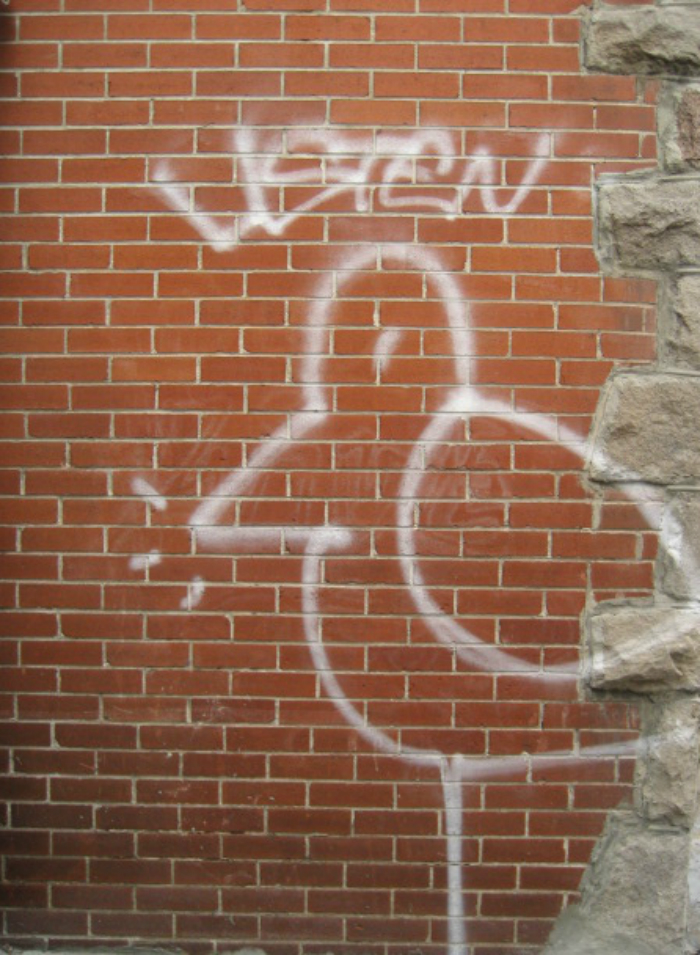 By Lauren Ernt
By Lauren Ernt
(French) It isn’t every day that a four-foot-tall bird orders me around, much less orders me around on a drizzly October afternoon in a Mile End alleyway. So when this charming aerosol stick figure chirped at me, “Listen,” I decided to pay attention. Despite what opening sentences might imply, this wasn’t some hallucinogenic trip down a rabbit hole. I was wading through a crush of autumn leaves with a tiny camera in hand, scanning the walls around me for Montreal street art.
Only a few days earlier, my friend Kathryn remarked that Rue Ste-Catherine, one of downtown Montreal’s busiest shopping streets, was surprisingly free of graffiti. “Really?” I squinted at her in disagreement. “Maybe not right here, but walk around—there’s plenty.” Two blocks later, puffy pastel text ballooned across the back of a department store. “Oh,” she said. “There it is.”
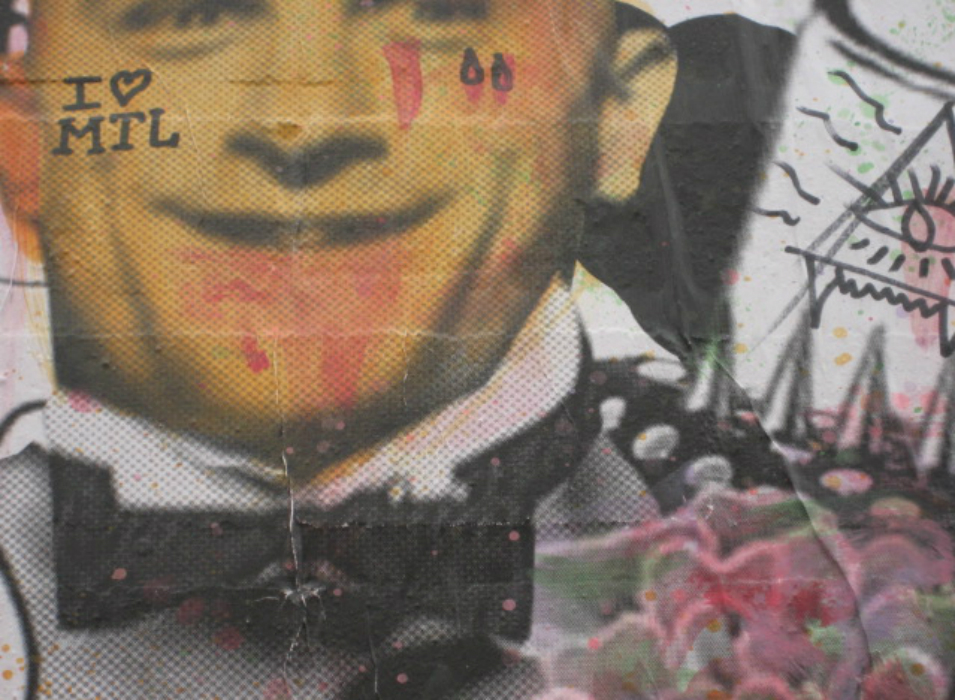 This is one of the things I like best about Montreal. Not postcard-ready walkups with spiral staircases, not its reputation for providing a “taste-of-Europe-in-North-America” experience, not even its nightlife—as much as I love leaving a bar at 3:00 a.m. knowing that poutine awaits me, somewhere. It’s the city’s many facets and layers. Montreal is happy to show off its historic grey stone facades and elegant department store vitrines, but its gritty side is never too far away.
This is one of the things I like best about Montreal. Not postcard-ready walkups with spiral staircases, not its reputation for providing a “taste-of-Europe-in-North-America” experience, not even its nightlife—as much as I love leaving a bar at 3:00 a.m. knowing that poutine awaits me, somewhere. It’s the city’s many facets and layers. Montreal is happy to show off its historic grey stone facades and elegant department store vitrines, but its gritty side is never too far away. 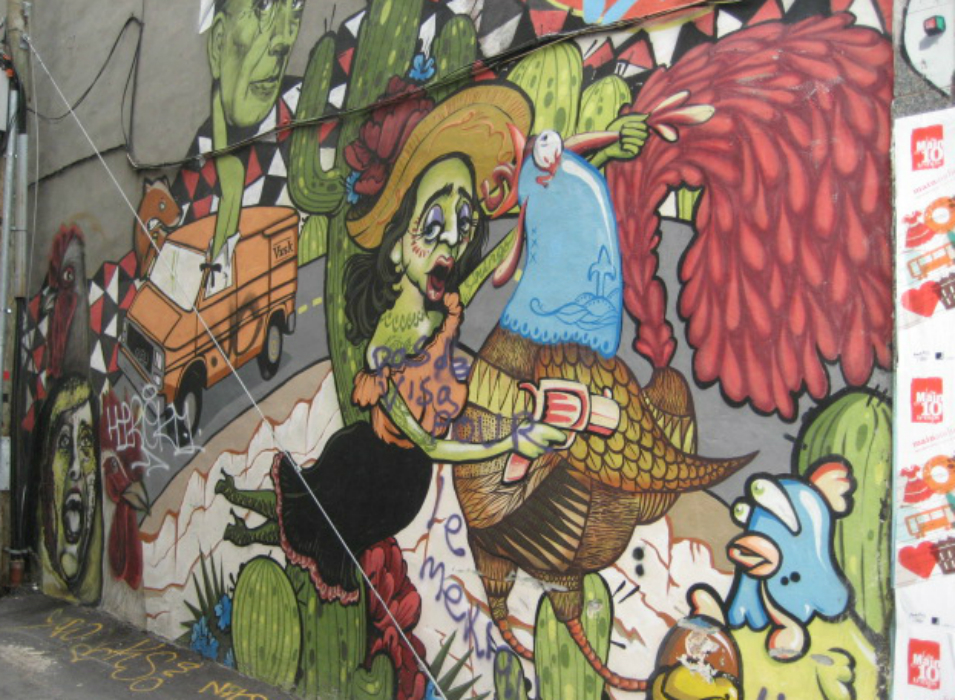 Strangers to the city might not be aware of Montreal’s diverse street art offerings, but it only takes a single quirky tag or striking mural to open your eyes to the city’s vibrant urban gallery.
Strangers to the city might not be aware of Montreal’s diverse street art offerings, but it only takes a single quirky tag or striking mural to open your eyes to the city’s vibrant urban gallery.
The conversation with Kathryn inspired me. Although I had spent four years living in Montreal as a student, it felt uncomfortably distant five years after graduation. Determined to reacquaint myself with the city, I set out on a week-long street art safari last autumn. From 2003 to 2007, I had been casually aware of the city’s ubiquitous thick graffiti and a few neighborhood murals (which I must have assumed were the exception in the landscape rather than the rule). But the variety of subjects, styles, and media represented in 2012 took me by surprise.
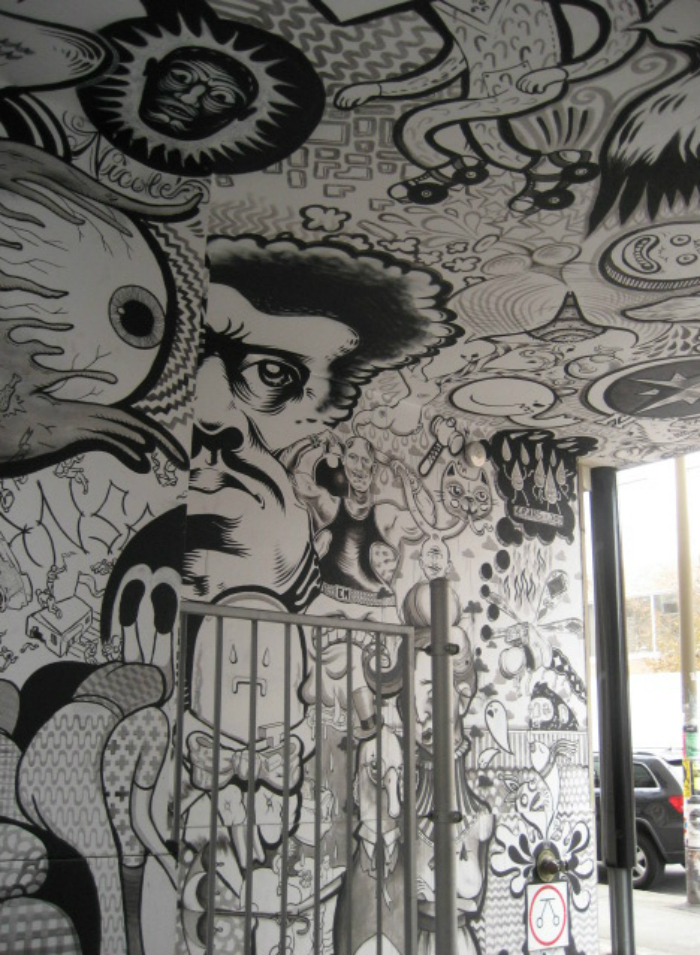 Abandoning all notions of itinerary, I wore out the soles of my shoes and the battery in my camera tracking street art through the Vieux-Port, downtown, the Plateau, Mile End, and Outremont neighborhoods, and anywhere else I could reach by foot. I peered around corners to find murals stretched across the sides of buildings like brick and stucco canvasses, depicting everything from the history of Québec to bakery menu items. They coexisted—though not always peacefully—with hasty teenage scrawls, stencils, and spray painted line drawings. Paper prints were pasted onto walls, some clean, some smoothed over years’ worth of snarled tags.
Abandoning all notions of itinerary, I wore out the soles of my shoes and the battery in my camera tracking street art through the Vieux-Port, downtown, the Plateau, Mile End, and Outremont neighborhoods, and anywhere else I could reach by foot. I peered around corners to find murals stretched across the sides of buildings like brick and stucco canvasses, depicting everything from the history of Québec to bakery menu items. They coexisted—though not always peacefully—with hasty teenage scrawls, stencils, and spray painted line drawings. Paper prints were pasted onto walls, some clean, some smoothed over years’ worth of snarled tags.
The only stylistic rule that I could discern was that there were no rules: the art could be rendered in wild color or stark black and white, and could just as easily take cues from Rivera and Orozco as from Toulouse-Lautrec, Marvel comics, or hip-hop culture. The tension between order and chaos was striking; it seemed that for every meticulously planned and executed 30-foot mural there was at least one scrambled palimpsest.
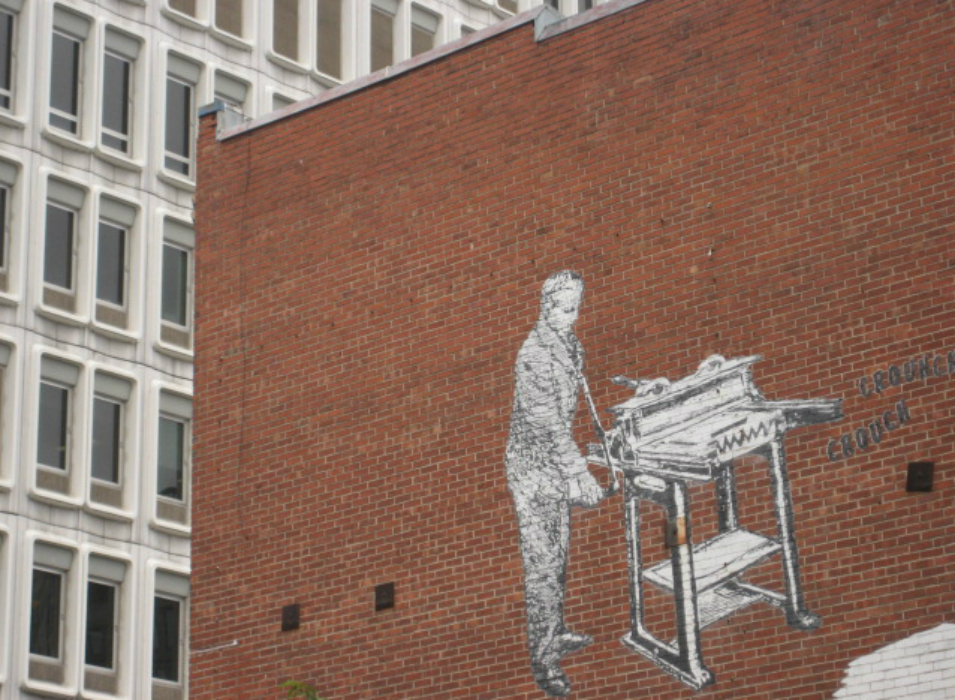 Unsurprisingly, the murals proudly displayed tags to identify the artists. Somewhat more surprising was the number of tags attributing them to nonprofit organizations. Whatever the organizations’ missions (reclaiming urban community space, promoting non-traditional artists, and supporting at-risk youth), their painstaking collaboration with artists, neighborhoods, business owners, and city officials was clear. I sincerely admired their missions and empathized with the artists every time I saw an offensive word or image grafted onto their work, but I couldn’t help but want to play devil’s advocate: in legitimizing one form of visual expression over another, could one alienate the very groups that the organizations wished to engage and rehabilitate? Or, in repainting a surface, what preexisting gems might have been obscured?
Unsurprisingly, the murals proudly displayed tags to identify the artists. Somewhat more surprising was the number of tags attributing them to nonprofit organizations. Whatever the organizations’ missions (reclaiming urban community space, promoting non-traditional artists, and supporting at-risk youth), their painstaking collaboration with artists, neighborhoods, business owners, and city officials was clear. I sincerely admired their missions and empathized with the artists every time I saw an offensive word or image grafted onto their work, but I couldn’t help but want to play devil’s advocate: in legitimizing one form of visual expression over another, could one alienate the very groups that the organizations wished to engage and rehabilitate? Or, in repainting a surface, what preexisting gems might have been obscured?
 Community stakeholders and artists’ advocates must debate these issues within Montreal, and in any other urban environment, for that matter. I don’t aim to resolve them here. I wish to explore a different relationship. No matter who the artist was or what technique or medium was employed, the artists interact and communicate with the city’s inhabitants simply by situating their work in the very public forum of the street. The expressive goals of community muralists, gangs, or politically-progressive stencil artists are obvious enough, but these are not the only messages to be found. More than once I was delighted to find sight gags sprinkled along the streets during my walks: a tiny camel figure transformed a speed-bump sign into sand dunes; subtle paw prints tracked through an alley to lead to their spray-painted feline owner. Their creators are not working in self-imposed vacuums. They have something to say, and want their work to be seen, experienced, digested, and enjoyed.
Community stakeholders and artists’ advocates must debate these issues within Montreal, and in any other urban environment, for that matter. I don’t aim to resolve them here. I wish to explore a different relationship. No matter who the artist was or what technique or medium was employed, the artists interact and communicate with the city’s inhabitants simply by situating their work in the very public forum of the street. The expressive goals of community muralists, gangs, or politically-progressive stencil artists are obvious enough, but these are not the only messages to be found. More than once I was delighted to find sight gags sprinkled along the streets during my walks: a tiny camel figure transformed a speed-bump sign into sand dunes; subtle paw prints tracked through an alley to lead to their spray-painted feline owner. Their creators are not working in self-imposed vacuums. They have something to say, and want their work to be seen, experienced, digested, and enjoyed.
People notice. Although my Montreal friends and acquaintances weren’t terribly enthusiastic about the more stereotypical graffiti, they certainly seemed to embrace the positive examples of creative output. Complete strangers approached me twice in a single day when they saw me photographing their favorite neighborhood specimens, excited to share with me what they knew. An elderly gentleman exiting a dépanneur (corner store) took the time to tell me how long a faded mural had adorned its exterior walls. I had the good fortune of photographing the stick figure bird right as one of its biggest fans walked by. “I love that bird!” he exclaimed. “I see him everywhere, and he’s perfectly rendered every time.”
 That moment reminded me very suddenly of what makes Montreal such a great city. It’s the unabashed engagement with its culture of creativity, whether it’s art displayed in a museum or lacquered over a loading dock. (Admission to the Musée de Beaux Arts, incidentally, is free of charge, though donations are encouraged.) You can see it in the summer’s weekend street festivals, free Jazz Festival concerts, and International Film Festival’s open-air cinema. It’s palpable even in the dead of winter during Montreal’s own frosty version of the internationally-celebrated nocturnal art crawl, Nuit Blanche. In a city where metropolitan annoyances (bad traffic, peculiar smells) couple with environmental hazards (frozen nostril hairs, nearly impenetrable walls of wind, an endless supply of precipitation in all its forms) to spawn the occasional unholy urban weather monster, Montrealers brave it all. They pull on parkas, boots, and touks in the winter and shed nearly every layer but skin in the summer, always excited to get out and enjoy what their city has to offer.
That moment reminded me very suddenly of what makes Montreal such a great city. It’s the unabashed engagement with its culture of creativity, whether it’s art displayed in a museum or lacquered over a loading dock. (Admission to the Musée de Beaux Arts, incidentally, is free of charge, though donations are encouraged.) You can see it in the summer’s weekend street festivals, free Jazz Festival concerts, and International Film Festival’s open-air cinema. It’s palpable even in the dead of winter during Montreal’s own frosty version of the internationally-celebrated nocturnal art crawl, Nuit Blanche. In a city where metropolitan annoyances (bad traffic, peculiar smells) couple with environmental hazards (frozen nostril hairs, nearly impenetrable walls of wind, an endless supply of precipitation in all its forms) to spawn the occasional unholy urban weather monster, Montrealers brave it all. They pull on parkas, boots, and touks in the winter and shed nearly every layer but skin in the summer, always excited to get out and enjoy what their city has to offer.
 Lauren Ernt, a long-time Francophile, completed her undergraduate degree at McGill University in Montréal in order to gain first-hand experience living in a Francophone environment. After graduating, she traveled to Annecy, France and worked as an English language teaching assistant. She now works as a publishing assistant. Her interests include reading, writing, language, music, movies, cycling, horseback riding, cooking, eating, and traveling, just to name a few.
Lauren Ernt, a long-time Francophile, completed her undergraduate degree at McGill University in Montréal in order to gain first-hand experience living in a Francophone environment. After graduating, she traveled to Annecy, France and worked as an English language teaching assistant. She now works as a publishing assistant. Her interests include reading, writing, language, music, movies, cycling, horseback riding, cooking, eating, and traveling, just to name a few.
You may also enjoy A Woman’s Paris® post, What’s in a Word? There’s more to French class than you thought. Jacqueline Bucar, French teacher and immigration attorney, invites us to stimulate a way of thinking and learning that expands our understanding of the world and ourselves through the study of a foreign language. She shares “what’s in a word,” a way of thinking, a “mentality” that helps define the people who speak it and their culture.
French Impressions: Lauren Ernt and her passion for literature and languages. Lauren Ernt, publishing assistant and long-time Francophile, writes about the use of language and the very tactile connection of language to words. She shares her love of French and English dictionaries; looking up words and examining their etymologies and then identifying where those French words have trickled into English in unexpected ways.
“Around and About Paris” – Montparnasse: Beneath its Surface (part one), is an invitation to scratch beneath its surface of dazzling vistas and imposing monuments and to probe the souls and lives of the restless people who throughout the ages have never ceased to shape it and reshape it, from the book Around and About Paris, volume one, by Thirza Vallois (used by permission). A travel and history guide through Montparnasse; including links to maps.
“Around and About Paris” – Montparnasse: Romantically Picturesque (part two), is a journey into the depths of Paris the magnificent: city of romance and drama, of triumph and tragedy, of farce and grandeur, of crime and passion, from the book Around and About Paris, volume one, by Thirza Vallois (used by permission). A travel and history guide through Montparnasse; including links to maps.
The Little Paris of Buenos Aires, by writer and educator Natalie Ehalt. Natalie writes about Recoleta, a premier barrio in Buenos Aires, Argentina, an irresistible Little Paris of South America. Until the sounds of thick Argentine Spanish reveal Recoleta’s true identity, a visitor might be fooled, stepping out of an urban rowboat and into a garden of 12,000 roses.
French Soap: Savon de Marseille, by writer Lauren Ernt who stumbled upon La Licorne, a storefront soap factory in the heart of Marseille and one of the last authentic manufacturers of the famous “savon de Marseille.” Lauren writes about her visit and love of this renowned soap for its purity and restorative properties.
French legend proved true with the discovery of blood of King Louis XVI in gourd, by Andrea Johnson who shares with us a stimulating morsel of French history that seems just a little more tangible as it occurs right before our eyes. (French)
Text copyright ©2013 Lauren Ernt. All rights reserved.
Illustration copyright ©2012 Lauren Ernt. All rights reserved.
Illustration copyright ©2012 Barbara Redmond. All rights reserved.
barbara@awomansparis.com

